The sewing machine electronic control system market is likely to reach from USD 2,257.5 million in 2025 to USD 3,819.7 million by 2035, reflecting a CAGR of 5.4%. The market demonstrates identifiable peaks and troughs over the decade, influenced by seasonal demand, technological upgrades, and regional adoption patterns. Early in the period, 2025 to 2027, the market reaches an initial peak as manufacturers of industrial and household sewing machines adopt electronic control systems to improve precision, automation, and user interface capabilities. Growth is supported by rising demand for high-speed stitching, energy efficiency, and integration with IoT-enabled production lines.
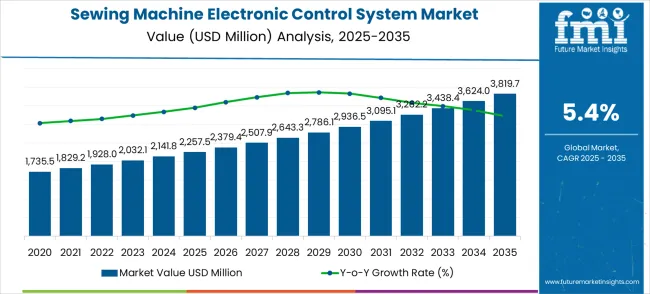
A subsequent trough occurs between 2028 and 2030, reflecting a temporary slowdown in regions where market penetration reaches maturity and replacement cycles dominate. During this period, incremental growth comes from minor technological improvements, software updates, and expansion into mid-sized production facilities. From 2031 to 2035, the market ascends again toward a higher peak as innovations such as advanced touch-screen interfaces, adaptive stitch control, and enhanced diagnostics drive renewed adoption. Expansion in emerging economies and the rising popularity of custom and smart sewing machines further strengthen growth. The peak-to-trough pattern highlights a market influenced by cyclical adoption, technological upgrades, and regional expansion, providing guidance for manufacturers to align production, marketing, and R&D strategies with demand fluctuations.
Current trends include integration of touchscreen interfaces, programmable stitch patterns, and IoT connectivity for monitoring and maintenance. Manufacturers are innovating with compact, energy-efficient, and modular control boards compatible with multiple machine types. Expansion into smart factories, automated textile production, and high-speed industrial embroidery is driving adoption. Partnerships between electronics suppliers and sewing machine OEMs enable customized, high-precision solutions. Focus on efficiency, versatility, and user-friendly operation continues to support global market growth while meeting evolving industry standards. The sewing machine electronic control system market is segmented into industrial sewing machines (40%), domestic and household machines (28%), embroidery and textile automation (18%), specialized sewing applications (9%), and research and prototyping units (5%). Industrial machines dominate adoption as electronic control systems provide precision stitching, speed regulation, and automation for high-volume textile production. Domestic and household machines increasingly use electronic controls for programmable patterns, efficiency, and ease of use. Embroidery and textile automation require precise, computer-controlled stitching, while specialized applications include leather, technical textiles, and automotive upholstery. Research and prototyping sectors adopt electronic controls for experimental designs and small-scale production runs.
| Metric | Value |
|---|---|
| Market Value (2025) | USD 2,257.5 million |
| Market Forecast Value (2035) | USD 3,819.7 million |
| Market Forecast CAGR | 5.4% |
Market expansion is being supported by the rapid increase in textile manufacturing automation worldwide and the corresponding need for precision electronic control systems that provide superior sewing accuracy and operational consistency. Modern textile facilities rely on consistent production quality and automated processes to ensure optimal manufacturing efficiency including garment production, technical textiles, and industrial fabric processing. Even minor control system inefficiencies can require comprehensive production protocol adjustments to maintain optimal quality standards and operational performance.
The growing complexity of textile manufacturing requirements and increasing demand for high-speed precision sewing solutions are driving demand for electronic control equipment from certified manufacturers with appropriate performance capabilities and technical expertise. Apparel manufacturing companies are increasingly requiring documented production efficiency and system reliability to maintain product quality and cost effectiveness. Industry specifications and quality standards are establishing standardized sewing procedures that require specialized electronic control technologies and trained operators.
The shift toward sustainable manufacturing practices and reduced waste generation is further accelerating adoption of precise electronic control systems that minimize material waste and optimize resource utilization. Smart manufacturing initiatives and Industry 4.0 implementation programs are creating demand for integrated control solutions that can communicate with broader factory management systems and provide real-time production analytics.
The market is segmented by classification, application, and region. By classification, the market is divided into integrated and modular systems. Based on application, the market is categorized into industrial sewing machines and household sewing machines. Regionally, the market is divided into North America, Europe, East Asia, South Asia & Pacific, Latin America, and Middle East & Africa.
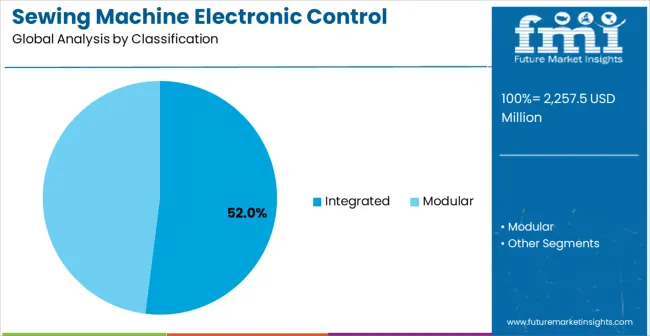
In 2025, the integrated sewing machine electronic control system segment is projected to capture around 52% of the total market share, making it the leading product category. This dominance is largely driven by the widespread adoption of comprehensive control solutions that combine multiple functions into single unified systems, catering to advanced manufacturing applications. The integrated control system is particularly favored for its ability to deliver seamless operation coordination between various sewing functions, ensuring operational efficiency and reduced complexity. Large-scale apparel manufacturers, automotive textile producers, and technical fabric companies increasingly prefer this classification, as it meets sophisticated production requirements without imposing excessive integration costs or operational complications.
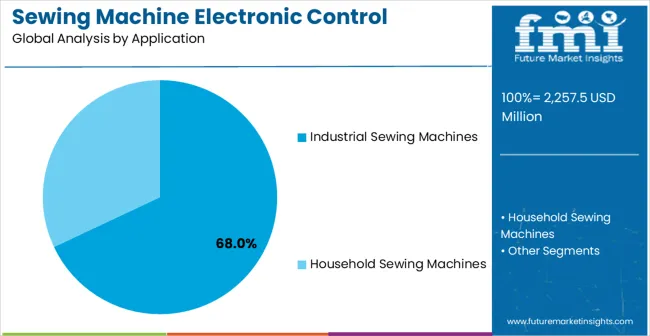
The industrial sewing machines segment is expected to represent 68% of electronic control system demand in 2025, highlighting its position as the most significant application sector. This dominance stems from the unique operational needs of industrial textile environments, where consistent high-speed production and precise control are critical to manufacturing efficiency. Industrial facilities often feature continuous operation requirements throughout extended shifts, requiring robust and reliable electronic control systems. Electronic control systems are particularly well-suited to these environments due to their ability to maintain consistent performance parameters and integrate with broader manufacturing execution systems. As industrial textile production expands globally and emphasizes improved automation standards, the demand for sophisticated electronic control systems continues to rise.
The Sewing Machine Electronic Control System market is advancing steadily due to increasing textile industry automation and growing recognition of electronic control advantages over manual operation methods. The market faces challenges including higher initial system costs compared to mechanical alternatives, need for specialized technical training for operators, and varying automation adoption rates across different geographic regions. Technology integration efforts and digitalization programs continue to influence system development and market adoption patterns.
The growing development of artificial intelligence and machine learning capabilities is enabling higher precision control with improved pattern recognition and adaptive operation characteristics. Enhanced AI technologies and optimized learning algorithms provide superior sewing quality while maintaining consistent performance across diverse materials and applications. These technologies are particularly valuable for large-scale manufacturers who require reliable system performance that can support extensive production operations with minimal manual intervention and consistent quality outcomes.
Modern electronic control system manufacturers are incorporating advanced connectivity features and Internet of Things capabilities that enhance system monitoring and predictive maintenance effectiveness. Integration of real-time data analytics and cloud-based monitoring enables superior production oversight and comprehensive performance optimization capabilities. Advanced connectivity features support operation in diverse manufacturing environments while meeting various productivity requirements and quality specifications, enabling seamless integration with enterprise resource planning systems.
The Sewing Machine Electronic Control System market is entering a new phase of growth, driven by demand for automation, industrial digitalization, and evolving manufacturing efficiency standards. By 2035, these pathways together can unlock USD 400-500 million in incremental revenue opportunities beyond baseline growth.
Pathway A -- Integrated System Leadership (Comprehensive Control Solutions) The integrated segment already holds the largest share due to its comprehensive functionality and operational efficiency. Expanding AI integration, machine learning capabilities, and advanced analytics can consolidate leadership. Opportunity pool: USD 120-150 million.
Pathway B -- Industrial Manufacturing Applications (Factory Automation) Industrial sewing machines account for the majority of demand. Growing manufacturing automation, especially in emerging economies, will drive higher adoption of sophisticated electronic control systems for production efficiency. Opportunity pool: USD 100-130 million.
Pathway C -- Smart Manufacturing & Industry 4.0 Integration Professional manufacturing facilities and smart factory initiatives are expanding, especially in developed markets. Control systems tailored for Industry 4.0 environments (IoT-enabled, cloud-connected, data-driven) can capture significant growth. Opportunity pool: USD 60-80 million.
Pathway D -- Emerging Market Expansion Asia-Pacific, Middle East, and Latin America present growing demand due to rising textile manufacturing infrastructure. Targeting distribution networks and cost-effective product lines will accelerate adoption. Opportunity pool: USD 40-60 million.
Pathway E -- Sustainability & Energy Efficiency with stricter environmental regulations and energy costs, there is an opportunity to promote energy-efficient control systems and sustainable manufacturing innovations. Opportunity pool: USD 30-40 million.
Pathway F -- Premium Technology Features Control systems with advanced pattern recognition, automatic material handling, and predictive maintenance offer premium positioning for high-end manufacturing facilities. Opportunity pool: USD 25-35 million.
Pathway G -- Service, Software & Lifecycle Value Recurring revenue from software updates, cloud services, and maintenance contracts creates a long-term revenue stream. Opportunity pool: USD 15-25 million.
Pathway H -- Digital Integration & Analytics Advanced analytics, machine learning insights, and digital twin technology can elevate electronic control systems into "intelligent manufacturing" solutions while strengthening customer relationships. Opportunity pool: USD 10-15 million.
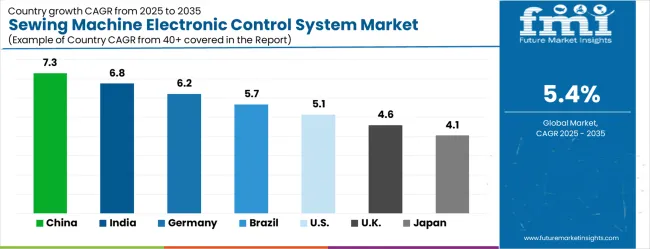
| Country | CAGR (2025-2035) |
|---|---|
| China | 7.3% |
| India | 6.8% |
| Germany | 6.2% |
| Brazil | 5.7% |
| United States | 5.1% |
| United Kingdom | 4.6% |
| Japan | 4.1% |
The sewing machine electronic control system market is growing rapidly, with China leading at a 7.3% CAGR through 2035, driven by massive textile manufacturing infrastructure and increasing adoption of automated production systems. India follows at 6.8%, supported by rising apparel manufacturing development and growing awareness of advanced control system solutions. Germany grows steadily at 6.2%, integrating electronic control technology into its established industrial textile infrastructure. Brazil records 5.7%, emphasizing manufacturing modernization and automation upgrade initiatives. The United States shows solid growth at 5.1%, focusing on technology advancement and operational efficiency. The United Kingdom demonstrates steady progress at 4.6%, maintaining established textile manufacturing applications. Japan records 4.1% growth, concentrating on precision technology development and quality optimization.
The report covers an in-depth analysis of 40+ countries, Top-performing countries are highlighted below.
China is expected to expand at a CAGR of 7.3% from 2025 to 2035, above the global average, due to increasing textile manufacturing and automation adoption. Electronic control systems in sewing machines are being implemented to enhance production efficiency, precision stitching, and integration with smart factory systems. Manufacturers focus on developing systems with programmable operations, touchscreen interfaces, and connectivity for monitoring production performance. Companies such as Brother Industries China and Juki Corporation are enhancing local production capabilities and introducing solutions for both industrial and home-use sewing machines. Rising demand for high-quality textiles, exports, and smart manufacturing technologies are further driving market growth.
India is anticipated to grow at a CAGR of 6.8% from 2025 to 2035, driven by textile and apparel manufacturing expansion and automation in small and large workshops. Electronic control systems improve stitching accuracy, reduce errors, and enhance productivity in industrial and home-use machines. Manufacturers focus on cost-effective, durable, and easy-to-use systems with programmable and automated functions. Companies such as Singer India and Shahi Exports are expanding production and introducing electronic control solutions compatible with a variety of fabrics. Government initiatives to support textile manufacturing and rising demand for mechanized production are accelerating market adoption.
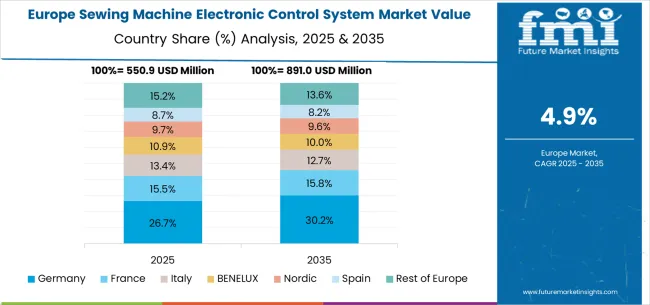
Germany is expected to grow at a CAGR of 6.2% from 2025 to 2035, supported by advanced textile manufacturing, precision engineering, and industrial automation. Electronic control systems are implemented to increase production efficiency, maintain high stitching accuracy, and integrate with factory monitoring systems. Manufacturers prioritize systems with flexible programming, high durability, and compatibility with different industrial sewing applications. Companies such as Pfaff Industries and Juki Germany are offering modular and programmable systems for industrial textile production. The market is further driven by the need for energy-efficient solutions, high-quality output, and integration with Industry 4.0 initiatives.
Brazil is expected to grow at a CAGR of 5.7% from 2025 to 2035, driven by textile industry expansion and increasing mechanization in both industrial and domestic sewing machines. Electronic control systems enhance production efficiency, stitching accuracy, and machine versatility. Manufacturers focus on cost-effective systems suitable for tropical climate conditions and varying production scales. Companies such as Singer Brazil and Janome Brazil are enhancing local production capabilities and introducing programmable systems for commercial and home-use machines. Demand is also supported by rising apparel exports and modernization of textile workshops.
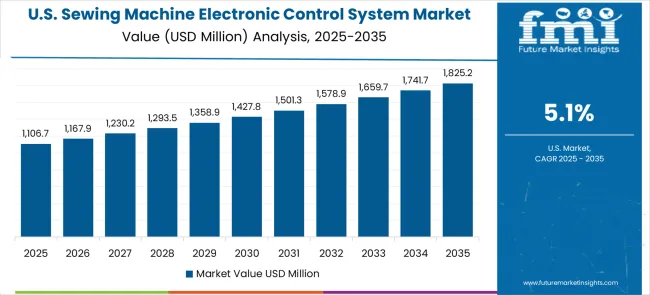
The United States is expected to grow at a CAGR of 5.1% from 2025 to 2035, supported by textile manufacturing, home sewing, and industrial automation. Electronic control systems are used to improve stitching precision, production efficiency, and machine versatility. Manufacturers focus on user-friendly interfaces, programmable functions, and integration with digital monitoring systems. Companies such as Brother Industries USA and Juki USA are offering modular electronic systems for industrial and home-use machines. Market adoption is further supported by the demand for high-quality textile production, customization, and automation in domestic and industrial environments.
The United Kingdom is expected to grow at a CAGR of 4.6% from 2025 to 2035, driven by textile manufacturing, tailoring workshops, and mechanization in home-use sewing machines. Electronic control systems improve stitching accuracy, speed, and adaptability to various fabrics. Manufacturers focus on compact, programmable, and energy-efficient systems suitable for small-scale and industrial sewing applications. Companies such as Janome UK and Singer UK are expanding offerings and integrating digital monitoring and automated functions. Growth is supported by government incentives for industrial modernization and the rise in custom apparel production.
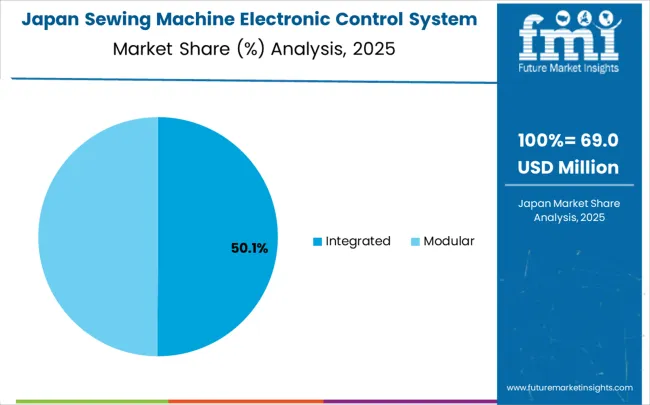
Japan is expected to grow at a CAGR of 4.1% from 2025 to 2035, reflecting steady adoption in industrial and home-use sewing applications. Electronic control systems are used to improve stitching precision, production efficiency, and integration with automated textile manufacturing. Manufacturers focus on high-quality, reliable, and compact systems with programmable functions and touchscreen interfaces. Companies such as Juki Corporation and Brother Industries Japan are developing advanced control systems for industrial and domestic machines. Market growth is influenced by technological innovation, high textile quality standards, and demand for smart, automated sewing solutions.
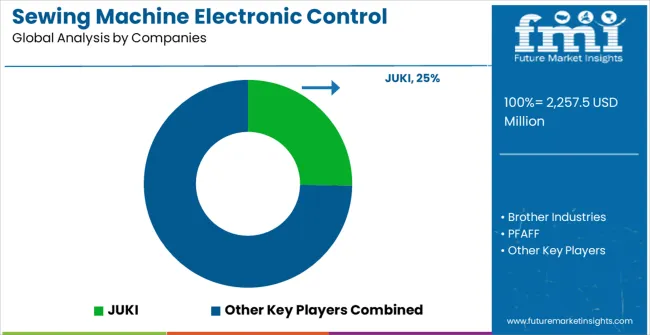
The sewing machine electronic control system market is defined by competition among specialized technology manufacturers, industrial automation companies, and textile machinery solution providers. Companies are investing in advanced electronic system development, AI integration, IoT connectivity improvements, and comprehensive service capabilities to deliver reliable, efficient, and intelligent control solutions. Strategic partnerships, technological innovation, and market expansion are central to strengthening product portfolios and market presence.
JUKI offers comprehensive electronic control solutions with established manufacturing expertise and industrial-grade system capabilities. Brother Industries provides integrated control systems with focus on reliability and user-friendly operation. PFAFF delivers advanced control technology with emphasis on precision and performance optimization. Karl Mayer specializes in technical textile control systems with advanced automation integration.
DaHao Technology offers professional-grade control systems with comprehensive software support capabilities. Xinghuo CNC Technology delivers specialized manufacturing control solutions with advanced CNC integration technologies. Raynen Systech provides innovative control systems with focus on connectivity and smart manufacturing features. Powermax Tech offers cost-effective control solutions with emphasis on accessibility and operational efficiency across global and regional market segments.
| Item | Value |
|---|---|
| Quantitative Units | USD 2,257.5 million |
| Classification | Integrated, Modular |
| Application | Industrial Sewing Machines, Household Sewing Machines |
| Regions Covered | North America, Europe, East Asia, South Asia & Pacific, Latin America, Middle East & Africa |
| Country Covered | China, India, Germany, Brazil, United States, United Kingdom, Japan, and 40+ countries |
| Key Companies Profiled | JUKI, Brother Industries, PFAFF, Karl Mayer, DaHao Technology, Xinghuo CNC Technology, Raynen Systech, Powermax Tech, Mitsubishi Electric, Siemens, Schneider Electric, ABB, Rockwell Automation, Omron, Fanuc |
| Additional Attributes | Dollar sales by classification and application segment, regional demand trends across major markets, competitive landscape with established control system manufacturers and emerging technology providers, customer preferences for different automation levels and connectivity options, integration with industrial manufacturing systems and quality control protocols, innovations in AI integration and machine learning capabilities, and adoption of IoT connectivity features with enhanced performance capabilities for improved operational workflows. |
The global sewing machine electronic control system market is estimated to be valued at USD 2,257.5 million in 2025.
The market size for the sewing machine electronic control system market is projected to reach USD 3,819.7 million by 2035.
The sewing machine electronic control system market is expected to grow at a 5.4% CAGR between 2025 and 2035.
The key product types in sewing machine electronic control system market are integrated and modular.
In terms of application, industrial sewing machines segment to command 68.0% share in the sewing machine electronic control system market in 2025.






Our Research Products

The "Full Research Suite" delivers actionable market intel, deep dives on markets or technologies, so clients act faster, cut risk, and unlock growth.

The Leaderboard benchmarks and ranks top vendors, classifying them as Established Leaders, Leading Challengers, or Disruptors & Challengers.

Locates where complements amplify value and substitutes erode it, forecasting net impact by horizon

We deliver granular, decision-grade intel: market sizing, 5-year forecasts, pricing, adoption, usage, revenue, and operational KPIs—plus competitor tracking, regulation, and value chains—across 60 countries broadly.

Spot the shifts before they hit your P&L. We track inflection points, adoption curves, pricing moves, and ecosystem plays to show where demand is heading, why it is changing, and what to do next across high-growth markets and disruptive tech

Real-time reads of user behavior. We track shifting priorities, perceptions of today’s and next-gen services, and provider experience, then pace how fast tech moves from trial to adoption, blending buyer, consumer, and channel inputs with social signals (#WhySwitch, #UX).

Partner with our analyst team to build a custom report designed around your business priorities. From analysing market trends to assessing competitors or crafting bespoke datasets, we tailor insights to your needs.
Supplier Intelligence
Discovery & Profiling
Capacity & Footprint
Performance & Risk
Compliance & Governance
Commercial Readiness
Who Supplies Whom
Scorecards & Shortlists
Playbooks & Docs
Category Intelligence
Definition & Scope
Demand & Use Cases
Cost Drivers
Market Structure
Supply Chain Map
Trade & Policy
Operating Norms
Deliverables
Buyer Intelligence
Account Basics
Spend & Scope
Procurement Model
Vendor Requirements
Terms & Policies
Entry Strategy
Pain Points & Triggers
Outputs
Pricing Analysis
Benchmarks
Trends
Should-Cost
Indexation
Landed Cost
Commercial Terms
Deliverables
Brand Analysis
Positioning & Value Prop
Share & Presence
Customer Evidence
Go-to-Market
Digital & Reputation
Compliance & Trust
KPIs & Gaps
Outputs
Full Research Suite comprises of:
Market outlook & trends analysis
Interviews & case studies
Strategic recommendations
Vendor profiles & capabilities analysis
5-year forecasts
8 regions and 60+ country-level data splits
Market segment data splits
12 months of continuous data updates
DELIVERED AS:
PDF EXCEL ONLINE
Sewing machine components Market Size and Share Forecast Outlook 2025 to 2035
Industrial Sewing Machines Market
Machine Glazed Paper Market Size and Share Forecast Outlook 2025 to 2035
Machine Glazed Kraft Paper Market Forecast and Outlook 2025 to 2035
Machine Condition Monitoring Market Size and Share Forecast Outlook 2025 to 2035
Machine Glazed Paper Industry Analysis in Asia Pacific Forecast Outlook 2025 to 2035
Machine Vision Camera Market Size and Share Forecast Outlook 2025 to 2035
Machine Tool Oils Market Size and Share Forecast Outlook 2025 to 2035
Machine Glazed Paper Industry Analysis in Western Europe Size and Share Forecast Outlook 2025 to 2035
Machine Glazed Paper Industry Analysis in Korea Size and Share Forecast Outlook 2025 to 2035
Machine Glazed Paper Industry Analysis in Japan Size and Share Forecast Outlook 2025 to 2035
Machine Tool Touch Probe Market Analysis - Size, Growth, and Forecast 2025 to 2035
Machine Mount Market Analysis - Size & Industry Trends 2025 to 2035
Machine-to-Machine (M2M) Connections Market – IoT & Smart Devices 2025 to 2035
Machine Safety Market Analysis by Component, Industry, and Region Through 2035
Key Players & Market Share in Machine Glazed Paper Industry
Machine Vision Market Insights – Growth & Forecast 2024-2034
Machine Learning As A Services Market
Machine Vision System And Services Market Size and Share Forecast Outlook 2025 to 2035
Machine Tool Cooling System Market Analysis - Size, Share, and Forecast Outlook 2025 to 2035

Thank you!
You will receive an email from our Business Development Manager. Please be sure to check your SPAM/JUNK folder too.
Chat With
MaRIA